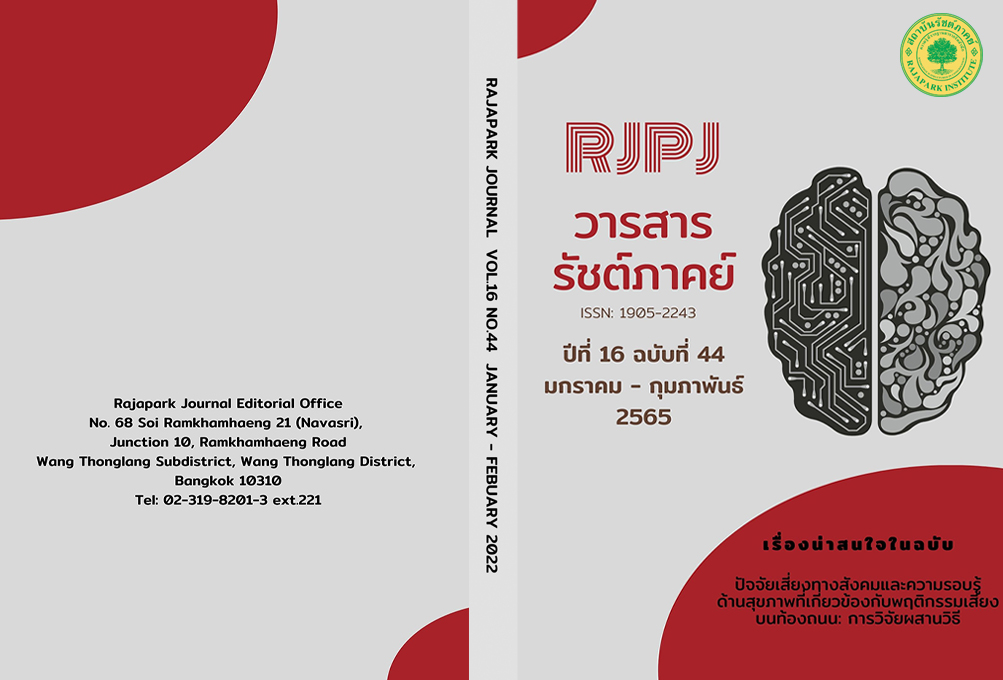Artificial Intelligent System for Multimedia Answering Presentations on Online Social Networks
Main Article Content
Abstract
The purposes of this study were 1) to develop an artificially intelligent system for multimedia answering presentations on online social networks, 2) to study the effects of implementing the developed artificial intelligent system for multimedia answering presentations on online social networks. The research methodology experimented with students of Chandrakasem Rajabhat University in the major of multimedia technology. The samples were 60 students. They were selected by a purposive sampling method, 30 students in an experimental group and 30 students in a control group. Research instruments consisted of 1) system model suitability assessment form, 2) system quality assessment form, 3) learning achievement test, and 4) satisfaction assessment form. Data were analyzed by using the arithmetic mean, standard deviation, and t-test. The research findings indicated that artificially intelligent systems for multimedia answering presentations on online social networks consisted of four components: 1) message and question analysis system, 2) knowledge database, 3) AI learning system, 4) multimedia answer delivery system. The suitability of the system model was validated at a “high” level. The quality of the developed system was validated at a “high” level by the black box testing technique. The efficiency of the developed system was validated at a “high” level. according to the KW-CAI criteria was 92%. The students’ learning achievement in the experimental group was “higher” than that in the control group at the level .01. The students rated their satisfaction with the developed system at the “high” level as well.
Article Details

This work is licensed under a Creative Commons Attribution-NonCommercial-NoDerivatives 4.0 International License.
Views and opinions appearing in the Journal it is the responsibility of the author of the article, and does not constitute the view and responsibility of the editorial team.
References
Chooamphai, C., & Srinuan, C. (2017). User Satisfaction Analysis of the Three-Accrual Basis Accounting Dimensions Software Program at Thailand’s King Mongkut’s Institute of Technology Ladkrabang. Journal of Management Sciences, 4(2), 143-173.
Jitmittraphap, S. (2010). Changing the world of learning in the 21st century and the development of “Professional teacher”. In Sudaphon Laksaneenawin (editor). 2010. Learning to change. Teacher Professional Development Network Association and Higher Education Organization of Thailand. Bangkok: Office of the Higher Education Commission, Ministry of Education.
Krabuanratt, K. (2021). The Development of Government's Personnel Management System. Mahidol R2R e-Journal, 8(1), 74-88.
Niamchoo, J., & Jaidumrong, N. (2019). Developing Multimedia Computer Instruction on Incorrect Position of Thai Ending Sound According to Thai Language Subject for Prathomsuksa 2 students. Lampang Rajabhat University Journal, 8(1), 2-16.
Noksi, S. (2021). The Development Of M-Learning Using Responsive Web Design On Creating Computer Assisted Instruction By Adobe Captivate 9 With Flipped Classroom For Undergraduate Students Of Nakhon Pathom Rajabhat University. CMU Journal of Education, 5(2), 5-39.
Phuttasorn, E. (2014). Trends in Enhancing of 21th Century Learning Skills for Adult Learners(Doctoral of formal Education). Chulalongkorn University.
Pramayan, N., Sanrach, C., & Krootjohn, S. (2015). A Development of Instruction System based on Multiple Intelligences Theory via Internet. Princess of Naradhiwas University Journal, 7(1), 58-70.
Samutthai, R. (2013). Pilot Research Development of Teacher Training Curriculum for the 21st Century. Chiang Mai University.
Tantitheerasak, S. (2016). The Practice of Peer Assisted Learning in Blended Learning with Social Networks to Promote Programming Skills for Matayomsuksa 5 students(Master of Education, Education Technology). Silpakorn University.
Trotter, E.T., & Tasker, P.S. (1980). Industry Trusted Computer System Evaluation Process. MITRE Technical Report.
Utermohlen, K. (2018). 4 Ways AI is Changing the Education Industry. Retrieved February 20, 2019, from https://towardsdatascience.com/4-ways-ai-is-changing-the-education-industry-b473c5d2c706
Wannaphapha, T. (2017). Social Media with Education. Journal of Education, Mahasarakham University. 11(1), 7-20.
Wuttipornchai, P., Bangbon, P., & Sinsomboonthong, R. (2017). Artificial Intelligence and Industrial Revolution 4. Journal of Pacific Institute of Management Sciences, 3(2), 213-218.
Yawirart, P., Kijkuakul, S., & Nakkuntod, M. (2020). Development Learning Management of Social Constructivism Integrate-Technology to Promote Communication Skills for Cooperation in Topic of Population for Grade 12th Students. Journal of Education, Naresuan University, 22(1), 162-174.


